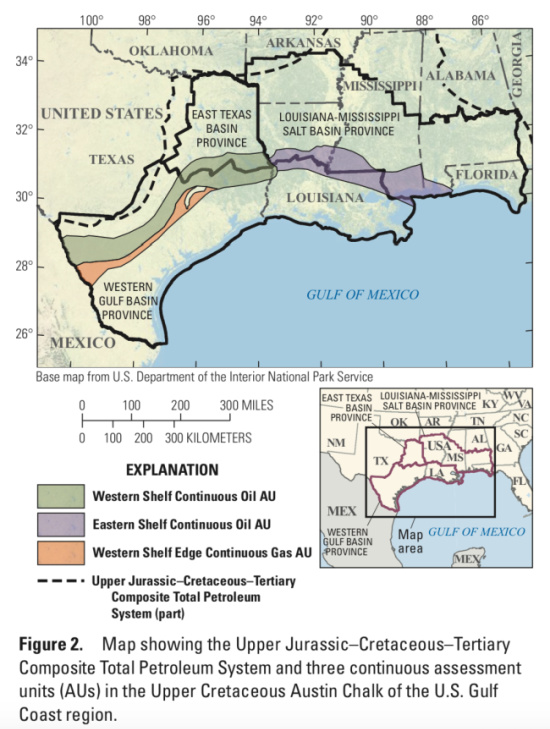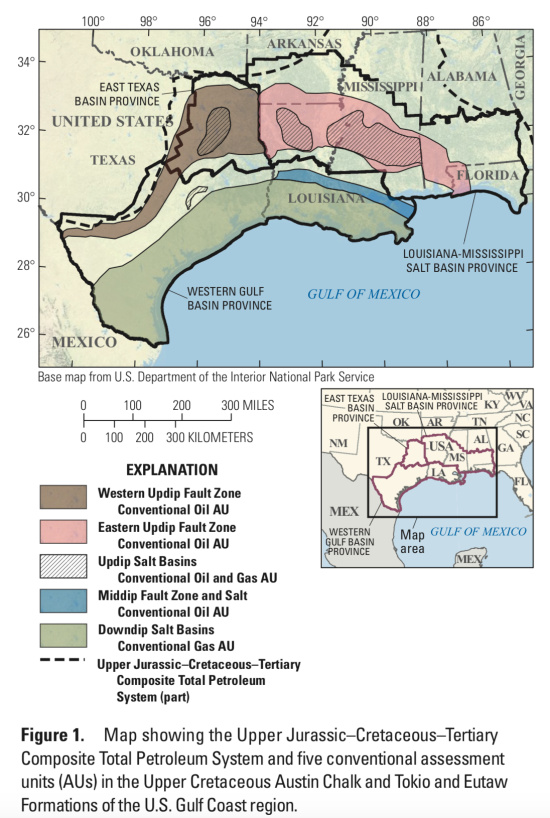
U.S. Geological Survey technicians at the USGS Gulf Coast #4 Bonham borehole prepare for geophysical logging of the Austin Chalk Group and the Eagle Ford Group mudstones in Fannin County, Texas. (Source: Stan Paxton/USGS)
Backed by advances in technology, continued drilling and a better understanding of geology and petroleum system characteristics, a newly released report shows the Austin Chalk, Tokio and Eutaw formations could hold about 6.9 billion barrels of oil and 41.5 trillion cubic feet of natural gas in undiscovered technically recoverable resources.
The updated assessment, focusing on the Upper Cretaceous geologic formation of the Gulf Coast Basin onshore and in state waters, was released Oct. 29 by the U.S. Geological Survey (USGS). It comes about a decade after the last assessment revealed the area had an estimated 957 MMbbl of undiscovered oil and 3.6 Tcf of gas.
The Austin Chalk has a long and storied history. While some companies have had success in parts of the play, others have struggled—battling massive amounts of water from fractures—in other areas.
RELATED
East Texas Chalk: It’s The Matrix
E&P Momentum: Austin Chalk Redux
Most of the resources are located in Texas, where companies such as EOG Resources Inc., Magnolia Oil & Gas Corp. and SM Energy Co. are among the players. The hydrocarbons are mainly sourced from “immediately underlying, thermally mature mudstone in the Upper Cretaceous (Cenomanian–Turonian) Eagle Ford Group,” according to the report.
“Texas is the state that just keeps on giving when it comes to oil and gas,” USGS Director Jim Reilly said in a statement. “Our assessment shows what can be accomplished through advances in technology by industry and the hard work our scientists put in to understanding the geology of petroleum systems in Texas.”
As part of the assessment, the USGS focused on eight assessment units (AUs)—five conventional and three continuous, which is defined by the USGS as oil and gas resources that are spread throughout a geologic formation and require special recovery methods such as horizontal drilling and hydraulic fracturing.
Of the continuous AUs, most of the undiscovered technically recoverable oil resources are on the Western Shelf—with estimates at nearly 6.6 Bbbl. The area extends west across the Maverick Basin to the Texas border with Mexico, according to the report. Most of the natural gas and NGL resources are located on the Western Shelf Edge with mean estimated undiscovered resources of about 26,142 Bcf of gas and 1,044 MMbbl of NGL.

Of the conventional oil and gas AUs, undiscovered oil resources were highest in the Updip Salt Basin, where the USGS report showed a mean of 10 MMbbl. Results also pointed to 17 Bcf of gas in each the Updip Salt Basin and Downdip Salt Basin AUs with the latter having the most NGL undiscovered resources at 9 MMbbl.

The area covered in the assessment spans from the Texas-Mexico border and arches across parts of Arkansas, Louisiana, Mississippi and into Alabama coastal area. “The Austin Chalk transitions into sandstone and mudstone of the Tokio Formation in Arkansas and Louisiana and the Eutaw Formation in Mississippi and Alabama,” according to the USGS.
Though the USGS said it believes the undiscovered resources highlighted in the assessment can be produced with existing technology and industry practices, “whether or not it is profitable to produce these resources has not been evaluated by the USGS.”
Recommended Reading
New Era Helium, Sharon AI Cement Permian Basin Data Center JV
2025-01-21 - New Era Helium and Sharon AI have created a JV, Texas Critical Data Centers, and are working on offtake gas supply agreements and site selection.
Diamondback in Talks to Build Permian NatGas Power for Data Centers
2025-02-26 - With ample gas production and surface acreage, Diamondback Energy is working to lure power producers and data center builders into the Permian Basin.
TGS to Reprocess Seismic Data in India’s Krishna-Godavari Basin
2025-01-28 - TGS will reprocess 3D seismic data, including 10,900 sq km of open acreage available in India’s upcoming 10th Open Acreage Licensing Policy (OALP) bid round blocks.
RoboTrucks Arrive in Permian Basin, Haul Proppant for Atlas Energy
2025-01-24 - Autonomous trucks developed by Kodiak Robotics delivered sand, off-road, for Atlas Energy Solutions’ Permian operations beginning in December.
Artificial Lift Firm Flowco Prices IPO Above Guidance at $427MM
2025-01-15 - Flowco Holdings priced its IPO at $24 per share, above its original guidance. The oilfield services firm will begin trading on the New York Stock Exchange on Jan. 16.
Comments
Add new comment
This conversation is moderated according to Hart Energy community rules. Please read the rules before joining the discussion. If you’re experiencing any technical problems, please contact our customer care team.






